Project Report on Marketing and Recruitment of University Courses
VerifiedAdded on 2022/11/25
|17
|4721
|70
Report
AI Summary
This report presents an executive summary of a project focused on the promotion and recruitment of university courses, specifically the creation of marketing materials for a workplace skills program. The project aimed to promote the program within the local community and recruit applicants for the September intake, including an interview and assessment process. The report details the application of various project management tools and techniques, such as project life cycle, QUAD chart, and stakeholder analysis. It assesses the project management abilities demonstrated throughout the project and includes recommendations for future improvements. The project's phases are outlined, covering initiation, planning, execution, and closure. The report also includes an analysis of stakeholder engagement and communication strategies. The report provides an overview of the project management tools and techniques used, along with an assessment of the project's success and recommendations for future projects.
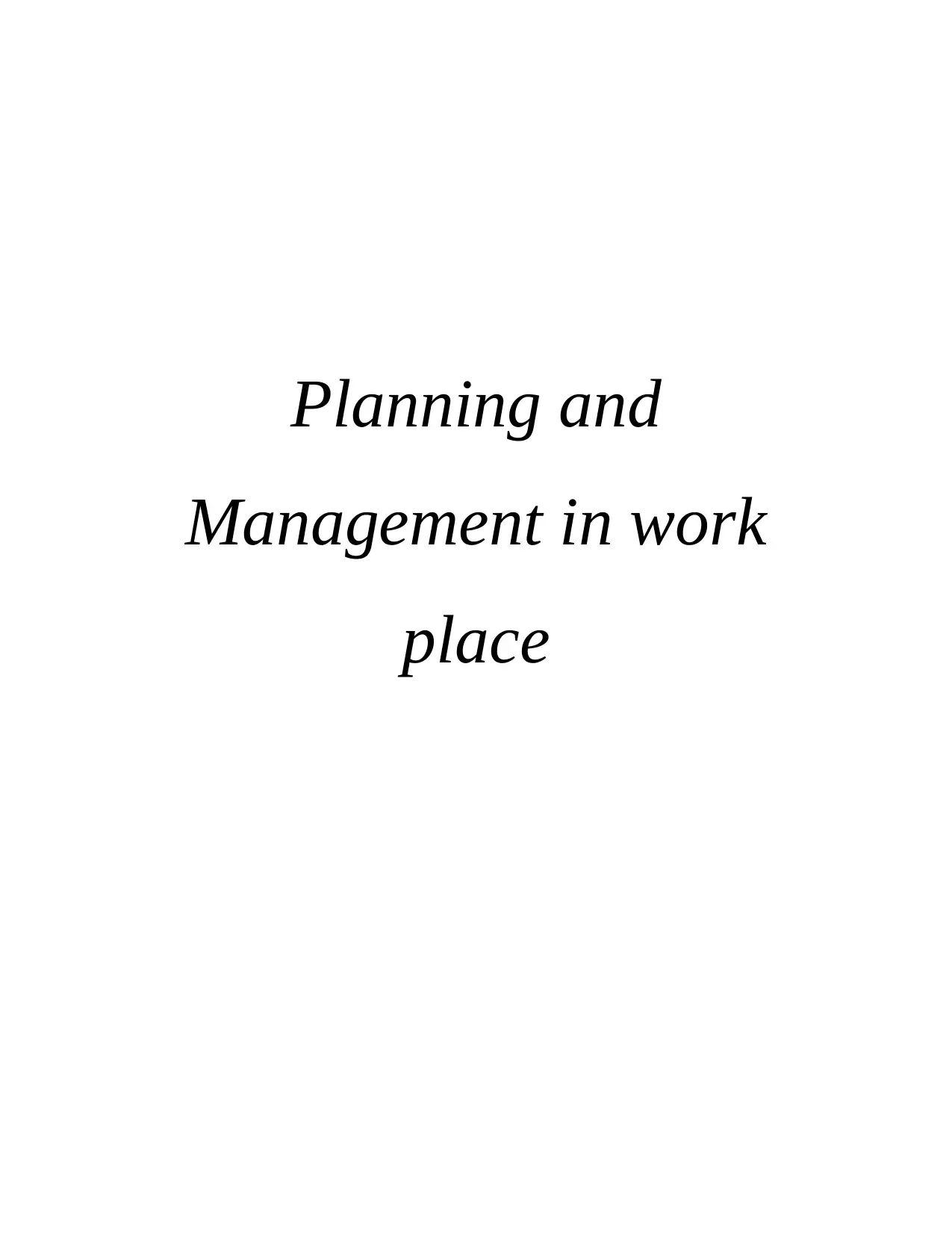
Planning and
Management in work
place
Management in work
place
Paraphrase This Document
Need a fresh take? Get an instant paraphrase of this document with our AI Paraphraser
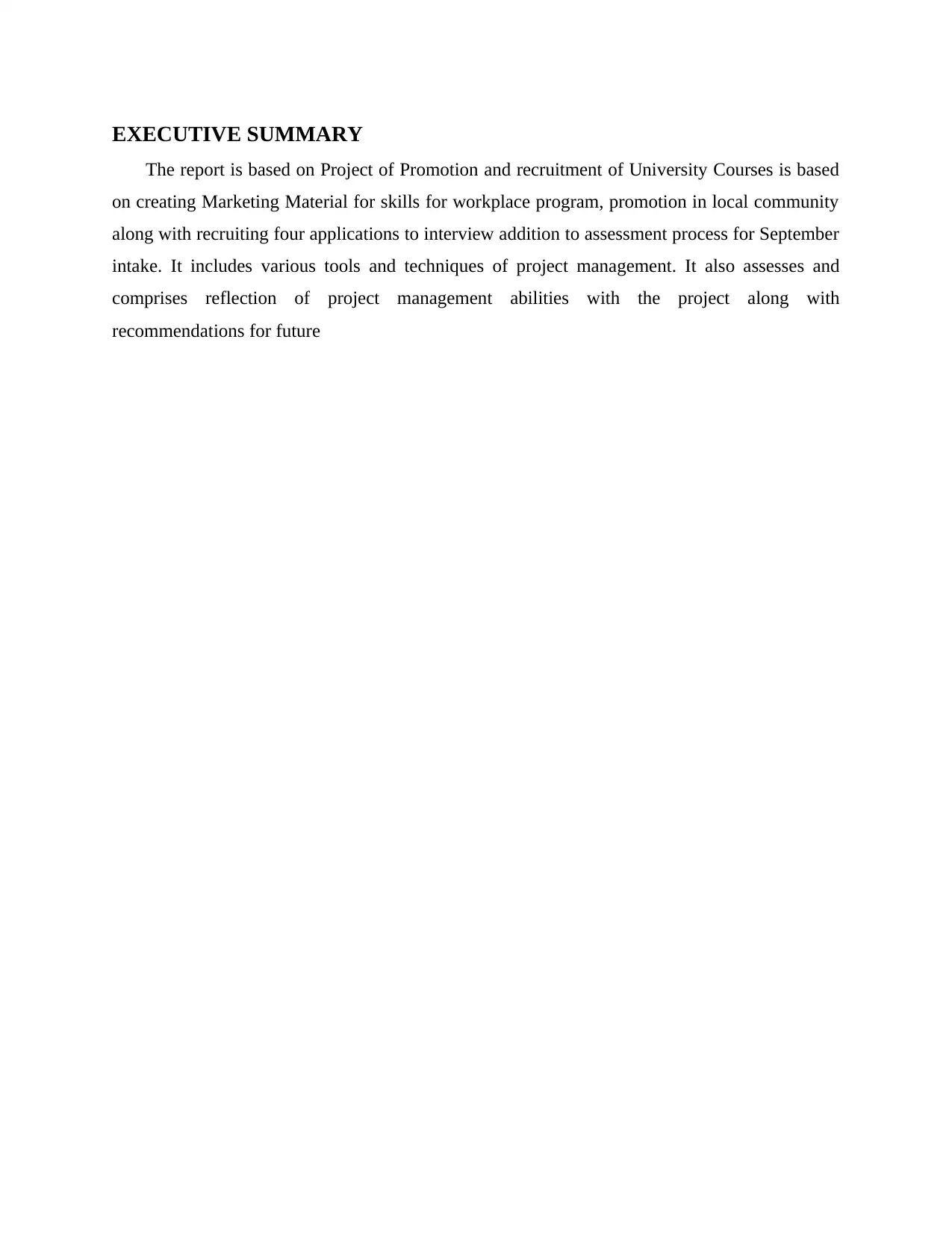
EXECUTIVE SUMMARY
The report is based on Project of Promotion and recruitment of University Courses is based
on creating Marketing Material for skills for workplace program, promotion in local community
along with recruiting four applications to interview addition to assessment process for September
intake. It includes various tools and techniques of project management. It also assesses and
comprises reflection of project management abilities with the project along with
recommendations for future
The report is based on Project of Promotion and recruitment of University Courses is based
on creating Marketing Material for skills for workplace program, promotion in local community
along with recruiting four applications to interview addition to assessment process for September
intake. It includes various tools and techniques of project management. It also assesses and
comprises reflection of project management abilities with the project along with
recommendations for future
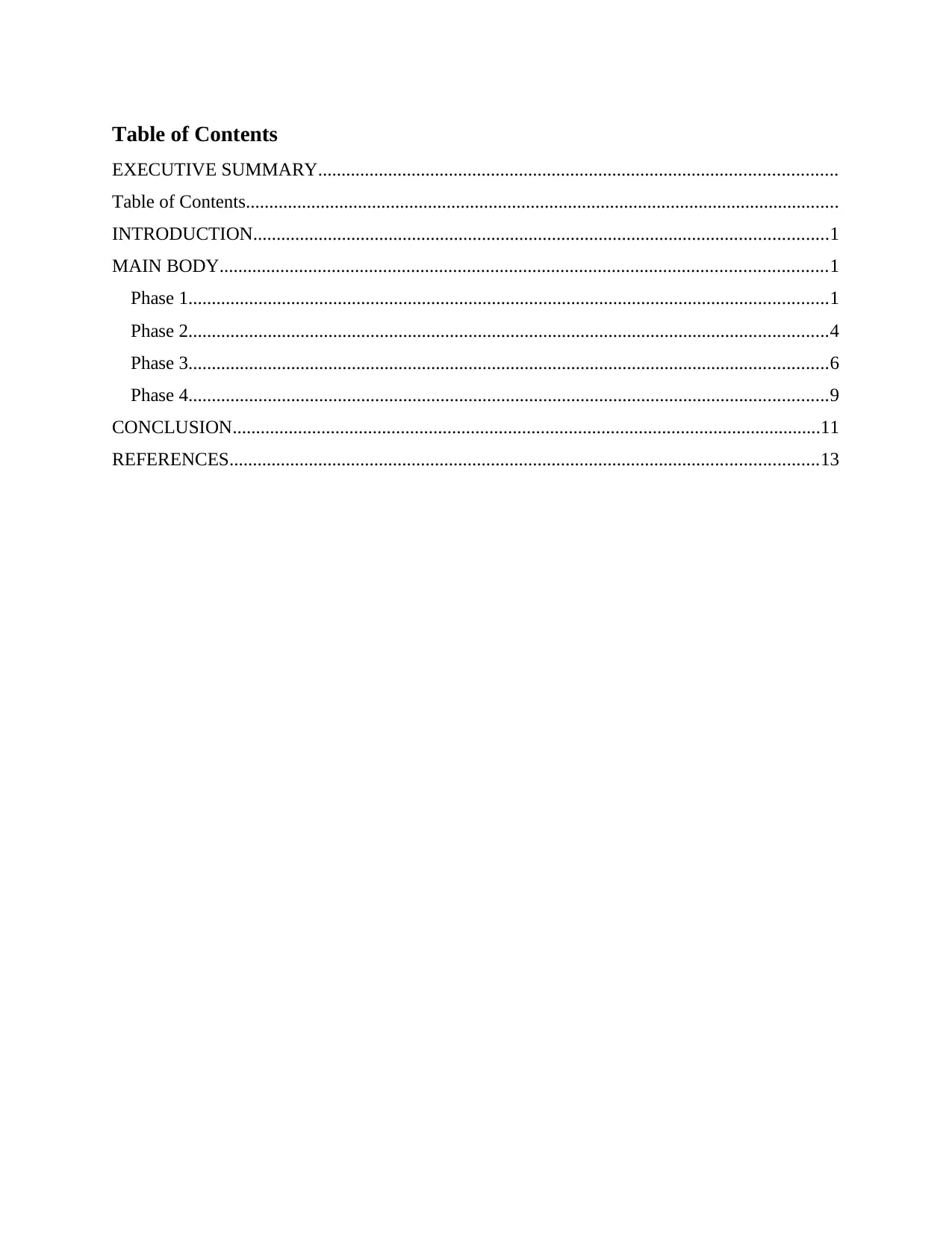
Table of Contents
EXECUTIVE SUMMARY...............................................................................................................
Table of Contents...............................................................................................................................
INTRODUCTION...........................................................................................................................1
MAIN BODY..................................................................................................................................1
Phase 1.........................................................................................................................................1
Phase 2.........................................................................................................................................4
Phase 3.........................................................................................................................................6
Phase 4.........................................................................................................................................9
CONCLUSION..............................................................................................................................11
REFERENCES..............................................................................................................................13
EXECUTIVE SUMMARY...............................................................................................................
Table of Contents...............................................................................................................................
INTRODUCTION...........................................................................................................................1
MAIN BODY..................................................................................................................................1
Phase 1.........................................................................................................................................1
Phase 2.........................................................................................................................................4
Phase 3.........................................................................................................................................6
Phase 4.........................................................................................................................................9
CONCLUSION..............................................................................................................................11
REFERENCES..............................................................................................................................13
⊘ This is a preview!⊘
Do you want full access?
Subscribe today to unlock all pages.

Trusted by 1+ million students worldwide
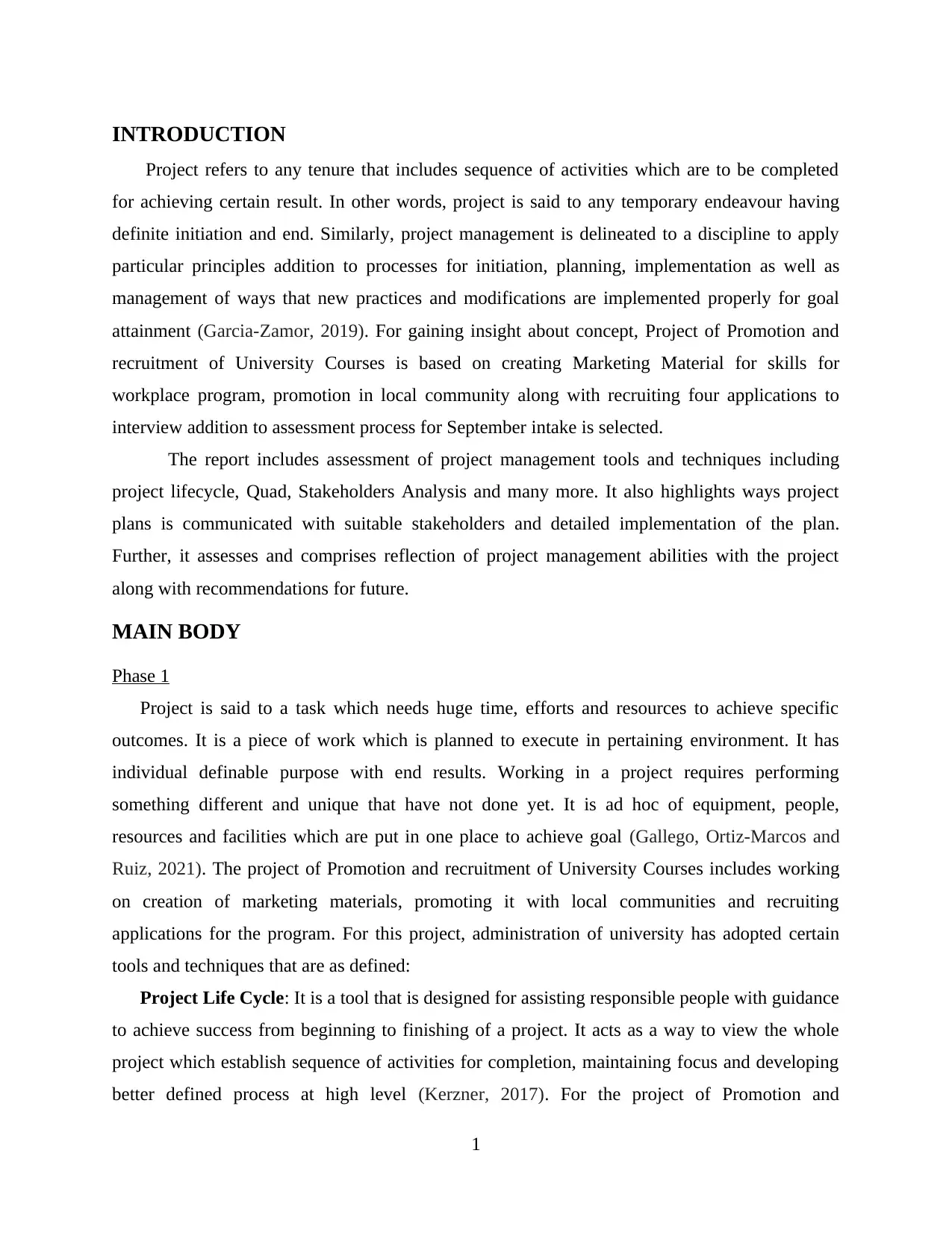
INTRODUCTION
Project refers to any tenure that includes sequence of activities which are to be completed
for achieving certain result. In other words, project is said to any temporary endeavour having
definite initiation and end. Similarly, project management is delineated to a discipline to apply
particular principles addition to processes for initiation, planning, implementation as well as
management of ways that new practices and modifications are implemented properly for goal
attainment (Garcia-Zamor, 2019). For gaining insight about concept, Project of Promotion and
recruitment of University Courses is based on creating Marketing Material for skills for
workplace program, promotion in local community along with recruiting four applications to
interview addition to assessment process for September intake is selected.
The report includes assessment of project management tools and techniques including
project lifecycle, Quad, Stakeholders Analysis and many more. It also highlights ways project
plans is communicated with suitable stakeholders and detailed implementation of the plan.
Further, it assesses and comprises reflection of project management abilities with the project
along with recommendations for future.
MAIN BODY
Phase 1
Project is said to a task which needs huge time, efforts and resources to achieve specific
outcomes. It is a piece of work which is planned to execute in pertaining environment. It has
individual definable purpose with end results. Working in a project requires performing
something different and unique that have not done yet. It is ad hoc of equipment, people,
resources and facilities which are put in one place to achieve goal (Gallego, Ortiz-Marcos and
Ruiz, 2021). The project of Promotion and recruitment of University Courses includes working
on creation of marketing materials, promoting it with local communities and recruiting
applications for the program. For this project, administration of university has adopted certain
tools and techniques that are as defined:
Project Life Cycle: It is a tool that is designed for assisting responsible people with guidance
to achieve success from beginning to finishing of a project. It acts as a way to view the whole
project which establish sequence of activities for completion, maintaining focus and developing
better defined process at high level (Kerzner, 2017). For the project of Promotion and
1
Project refers to any tenure that includes sequence of activities which are to be completed
for achieving certain result. In other words, project is said to any temporary endeavour having
definite initiation and end. Similarly, project management is delineated to a discipline to apply
particular principles addition to processes for initiation, planning, implementation as well as
management of ways that new practices and modifications are implemented properly for goal
attainment (Garcia-Zamor, 2019). For gaining insight about concept, Project of Promotion and
recruitment of University Courses is based on creating Marketing Material for skills for
workplace program, promotion in local community along with recruiting four applications to
interview addition to assessment process for September intake is selected.
The report includes assessment of project management tools and techniques including
project lifecycle, Quad, Stakeholders Analysis and many more. It also highlights ways project
plans is communicated with suitable stakeholders and detailed implementation of the plan.
Further, it assesses and comprises reflection of project management abilities with the project
along with recommendations for future.
MAIN BODY
Phase 1
Project is said to a task which needs huge time, efforts and resources to achieve specific
outcomes. It is a piece of work which is planned to execute in pertaining environment. It has
individual definable purpose with end results. Working in a project requires performing
something different and unique that have not done yet. It is ad hoc of equipment, people,
resources and facilities which are put in one place to achieve goal (Gallego, Ortiz-Marcos and
Ruiz, 2021). The project of Promotion and recruitment of University Courses includes working
on creation of marketing materials, promoting it with local communities and recruiting
applications for the program. For this project, administration of university has adopted certain
tools and techniques that are as defined:
Project Life Cycle: It is a tool that is designed for assisting responsible people with guidance
to achieve success from beginning to finishing of a project. It acts as a way to view the whole
project which establish sequence of activities for completion, maintaining focus and developing
better defined process at high level (Kerzner, 2017). For the project of Promotion and
1
Paraphrase This Document
Need a fresh take? Get an instant paraphrase of this document with our AI Paraphraser
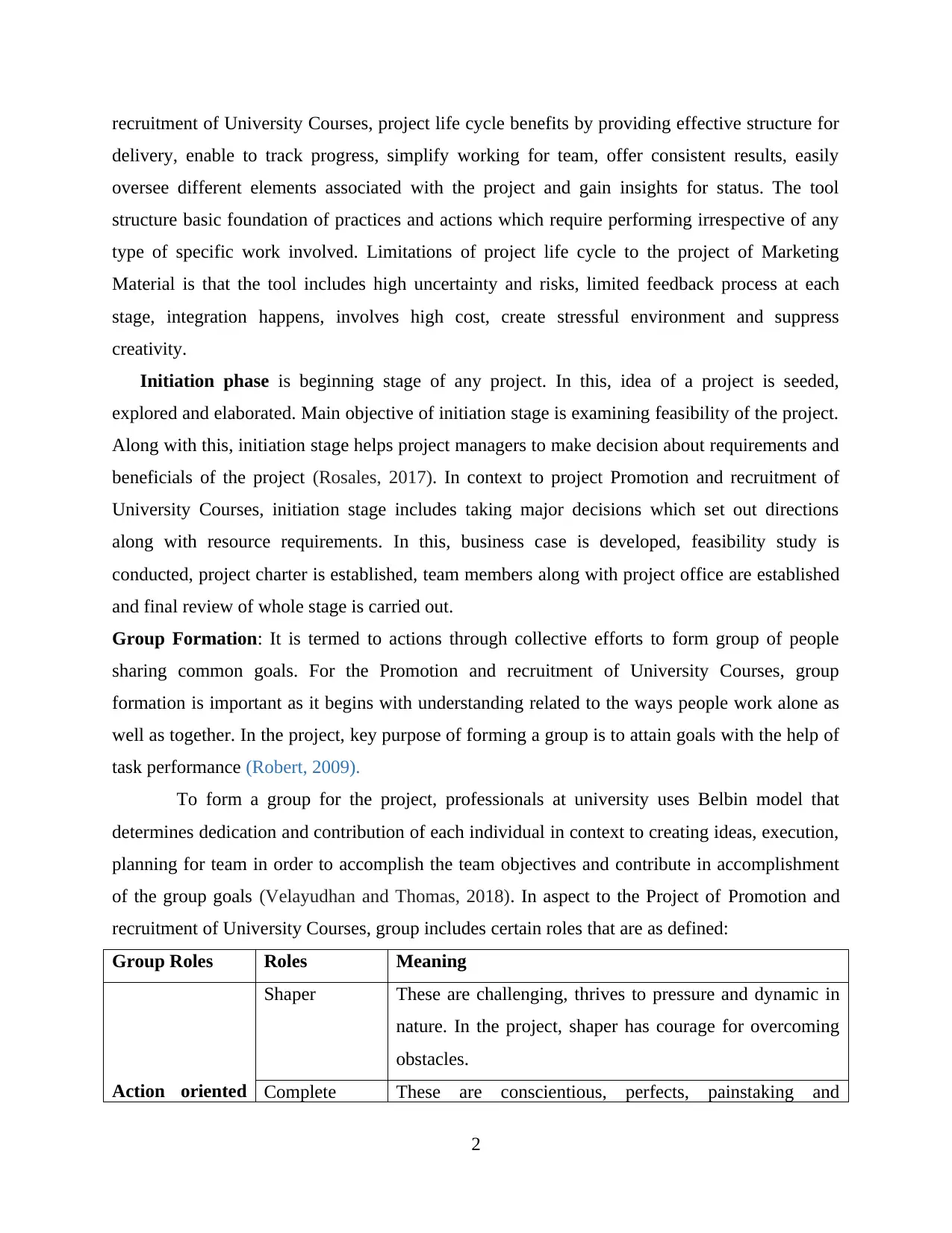
recruitment of University Courses, project life cycle benefits by providing effective structure for
delivery, enable to track progress, simplify working for team, offer consistent results, easily
oversee different elements associated with the project and gain insights for status. The tool
structure basic foundation of practices and actions which require performing irrespective of any
type of specific work involved. Limitations of project life cycle to the project of Marketing
Material is that the tool includes high uncertainty and risks, limited feedback process at each
stage, integration happens, involves high cost, create stressful environment and suppress
creativity.
Initiation phase is beginning stage of any project. In this, idea of a project is seeded,
explored and elaborated. Main objective of initiation stage is examining feasibility of the project.
Along with this, initiation stage helps project managers to make decision about requirements and
beneficials of the project (Rosales, 2017). In context to project Promotion and recruitment of
University Courses, initiation stage includes taking major decisions which set out directions
along with resource requirements. In this, business case is developed, feasibility study is
conducted, project charter is established, team members along with project office are established
and final review of whole stage is carried out.
Group Formation: It is termed to actions through collective efforts to form group of people
sharing common goals. For the Promotion and recruitment of University Courses, group
formation is important as it begins with understanding related to the ways people work alone as
well as together. In the project, key purpose of forming a group is to attain goals with the help of
task performance (Robert, 2009).
To form a group for the project, professionals at university uses Belbin model that
determines dedication and contribution of each individual in context to creating ideas, execution,
planning for team in order to accomplish the team objectives and contribute in accomplishment
of the group goals (Velayudhan and Thomas, 2018). In aspect to the Project of Promotion and
recruitment of University Courses, group includes certain roles that are as defined:
Group Roles Roles Meaning
Action oriented
Shaper These are challenging, thrives to pressure and dynamic in
nature. In the project, shaper has courage for overcoming
obstacles.
Complete These are conscientious, perfects, painstaking and
2
delivery, enable to track progress, simplify working for team, offer consistent results, easily
oversee different elements associated with the project and gain insights for status. The tool
structure basic foundation of practices and actions which require performing irrespective of any
type of specific work involved. Limitations of project life cycle to the project of Marketing
Material is that the tool includes high uncertainty and risks, limited feedback process at each
stage, integration happens, involves high cost, create stressful environment and suppress
creativity.
Initiation phase is beginning stage of any project. In this, idea of a project is seeded,
explored and elaborated. Main objective of initiation stage is examining feasibility of the project.
Along with this, initiation stage helps project managers to make decision about requirements and
beneficials of the project (Rosales, 2017). In context to project Promotion and recruitment of
University Courses, initiation stage includes taking major decisions which set out directions
along with resource requirements. In this, business case is developed, feasibility study is
conducted, project charter is established, team members along with project office are established
and final review of whole stage is carried out.
Group Formation: It is termed to actions through collective efforts to form group of people
sharing common goals. For the Promotion and recruitment of University Courses, group
formation is important as it begins with understanding related to the ways people work alone as
well as together. In the project, key purpose of forming a group is to attain goals with the help of
task performance (Robert, 2009).
To form a group for the project, professionals at university uses Belbin model that
determines dedication and contribution of each individual in context to creating ideas, execution,
planning for team in order to accomplish the team objectives and contribute in accomplishment
of the group goals (Velayudhan and Thomas, 2018). In aspect to the Project of Promotion and
recruitment of University Courses, group includes certain roles that are as defined:
Group Roles Roles Meaning
Action oriented
Shaper These are challenging, thrives to pressure and dynamic in
nature. In the project, shaper has courage for overcoming
obstacles.
Complete These are conscientious, perfects, painstaking and
2
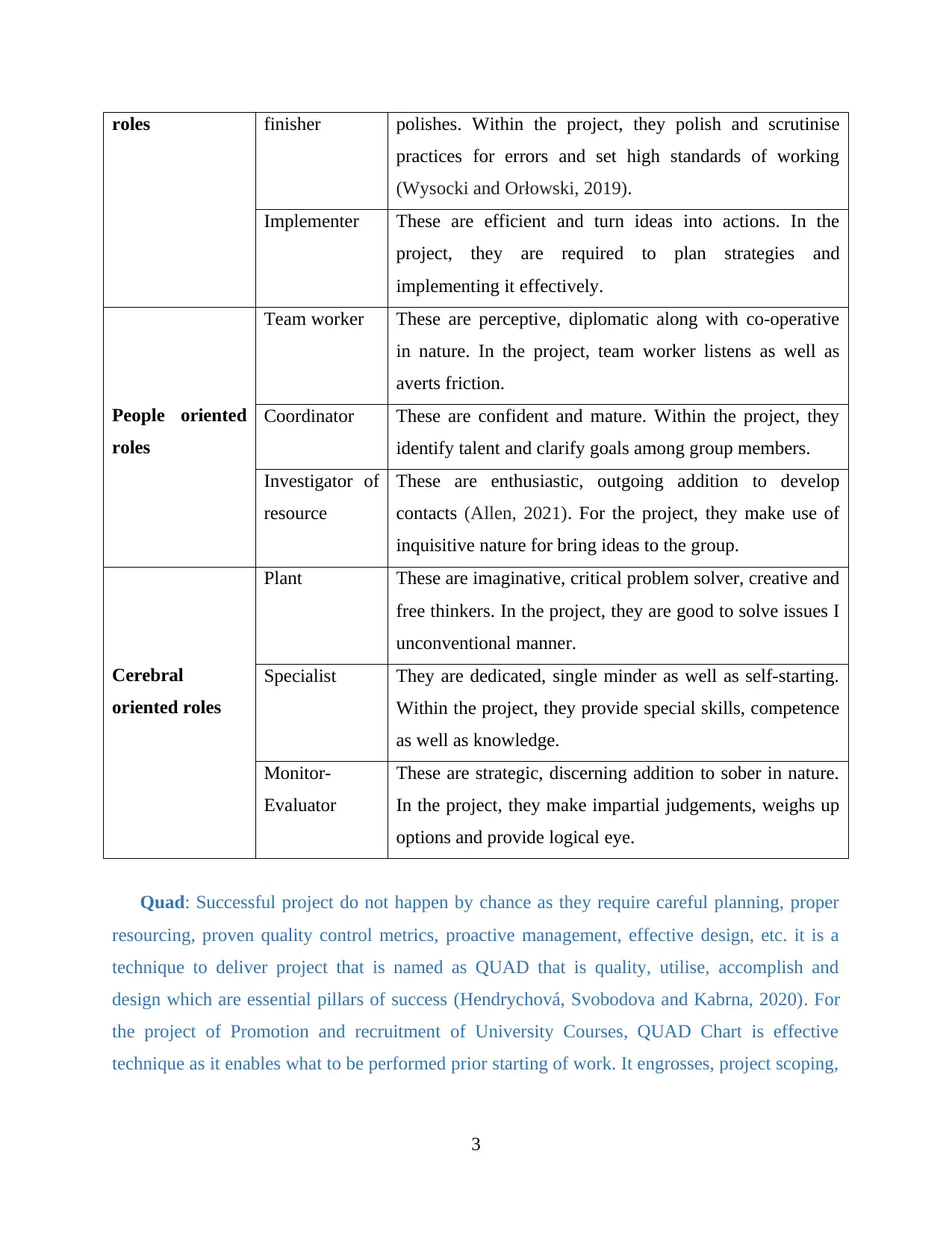
roles finisher polishes. Within the project, they polish and scrutinise
practices for errors and set high standards of working
(Wysocki and Orłowski, 2019).
Implementer These are efficient and turn ideas into actions. In the
project, they are required to plan strategies and
implementing it effectively.
People oriented
roles
Team worker These are perceptive, diplomatic along with co-operative
in nature. In the project, team worker listens as well as
averts friction.
Coordinator These are confident and mature. Within the project, they
identify talent and clarify goals among group members.
Investigator of
resource
These are enthusiastic, outgoing addition to develop
contacts (Allen, 2021). For the project, they make use of
inquisitive nature for bring ideas to the group.
Cerebral
oriented roles
Plant These are imaginative, critical problem solver, creative and
free thinkers. In the project, they are good to solve issues I
unconventional manner.
Specialist They are dedicated, single minder as well as self-starting.
Within the project, they provide special skills, competence
as well as knowledge.
Monitor-
Evaluator
These are strategic, discerning addition to sober in nature.
In the project, they make impartial judgements, weighs up
options and provide logical eye.
Quad: Successful project do not happen by chance as they require careful planning, proper
resourcing, proven quality control metrics, proactive management, effective design, etc. it is a
technique to deliver project that is named as QUAD that is quality, utilise, accomplish and
design which are essential pillars of success (Hendrychová, Svobodova and Kabrna, 2020). For
the project of Promotion and recruitment of University Courses, QUAD Chart is effective
technique as it enables what to be performed prior starting of work. It engrosses, project scoping,
3
practices for errors and set high standards of working
(Wysocki and Orłowski, 2019).
Implementer These are efficient and turn ideas into actions. In the
project, they are required to plan strategies and
implementing it effectively.
People oriented
roles
Team worker These are perceptive, diplomatic along with co-operative
in nature. In the project, team worker listens as well as
averts friction.
Coordinator These are confident and mature. Within the project, they
identify talent and clarify goals among group members.
Investigator of
resource
These are enthusiastic, outgoing addition to develop
contacts (Allen, 2021). For the project, they make use of
inquisitive nature for bring ideas to the group.
Cerebral
oriented roles
Plant These are imaginative, critical problem solver, creative and
free thinkers. In the project, they are good to solve issues I
unconventional manner.
Specialist They are dedicated, single minder as well as self-starting.
Within the project, they provide special skills, competence
as well as knowledge.
Monitor-
Evaluator
These are strategic, discerning addition to sober in nature.
In the project, they make impartial judgements, weighs up
options and provide logical eye.
Quad: Successful project do not happen by chance as they require careful planning, proper
resourcing, proven quality control metrics, proactive management, effective design, etc. it is a
technique to deliver project that is named as QUAD that is quality, utilise, accomplish and
design which are essential pillars of success (Hendrychová, Svobodova and Kabrna, 2020). For
the project of Promotion and recruitment of University Courses, QUAD Chart is effective
technique as it enables what to be performed prior starting of work. It engrosses, project scoping,
3
⊘ This is a preview!⊘
Do you want full access?
Subscribe today to unlock all pages.

Trusted by 1+ million students worldwide
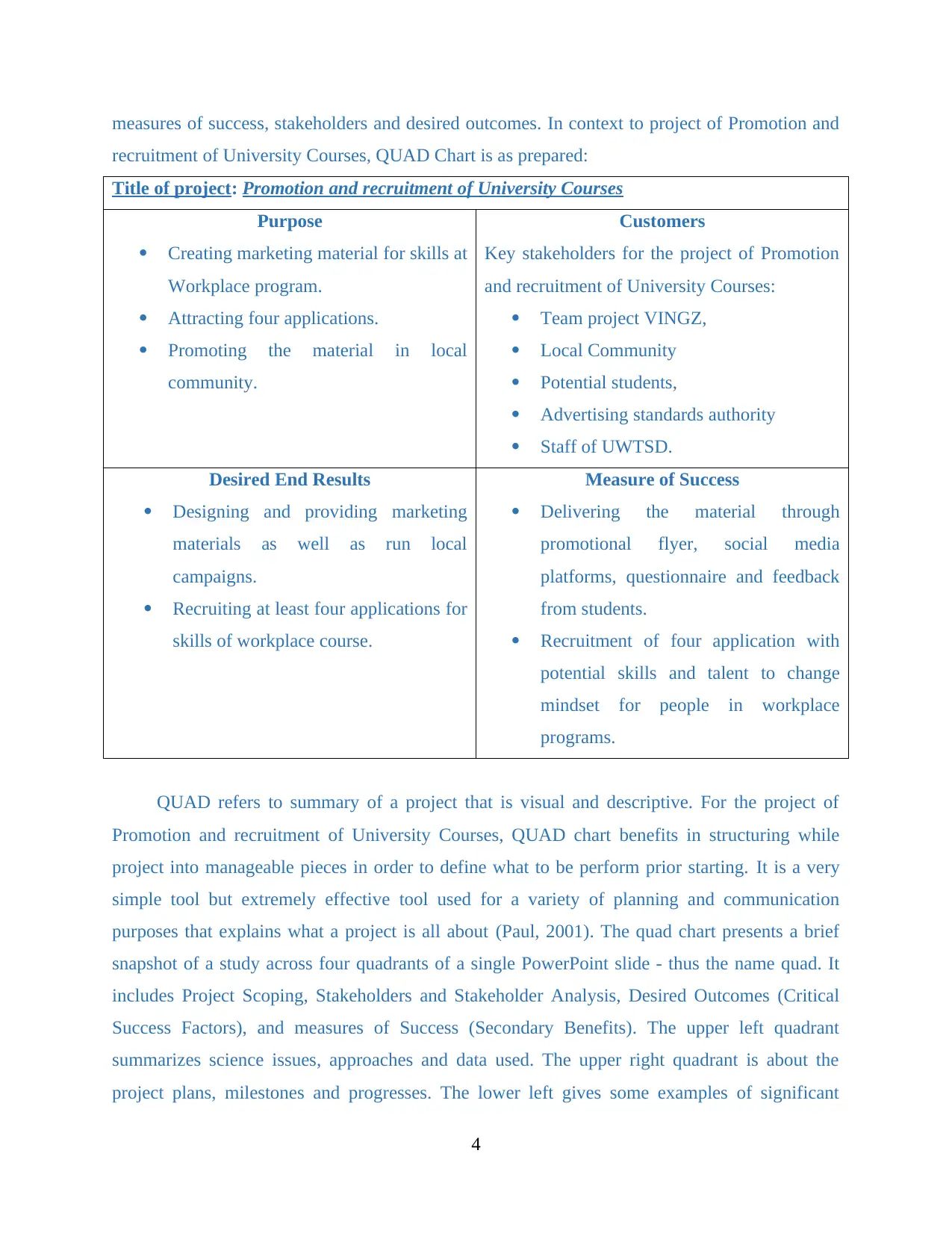
measures of success, stakeholders and desired outcomes. In context to project of Promotion and
recruitment of University Courses, QUAD Chart is as prepared:
Title of project: Promotion and recruitment of University Courses
Purpose
Creating marketing material for skills at
Workplace program.
Attracting four applications.
Promoting the material in local
community.
Customers
Key stakeholders for the project of Promotion
and recruitment of University Courses:
Team project VINGZ,
Local Community
Potential students,
Advertising standards authority
Staff of UWTSD.
Desired End Results
Designing and providing marketing
materials as well as run local
campaigns.
Recruiting at least four applications for
skills of workplace course.
Measure of Success
Delivering the material through
promotional flyer, social media
platforms, questionnaire and feedback
from students.
Recruitment of four application with
potential skills and talent to change
mindset for people in workplace
programs.
QUAD refers to summary of a project that is visual and descriptive. For the project of
Promotion and recruitment of University Courses, QUAD chart benefits in structuring while
project into manageable pieces in order to define what to be perform prior starting. It is a very
simple tool but extremely effective tool used for a variety of planning and communication
purposes that explains what a project is all about (Paul, 2001). The quad chart presents a brief
snapshot of a study across four quadrants of a single PowerPoint slide - thus the name quad. It
includes Project Scoping, Stakeholders and Stakeholder Analysis, Desired Outcomes (Critical
Success Factors), and measures of Success (Secondary Benefits). The upper left quadrant
summarizes science issues, approaches and data used. The upper right quadrant is about the
project plans, milestones and progresses. The lower left gives some examples of significant
4
recruitment of University Courses, QUAD Chart is as prepared:
Title of project: Promotion and recruitment of University Courses
Purpose
Creating marketing material for skills at
Workplace program.
Attracting four applications.
Promoting the material in local
community.
Customers
Key stakeholders for the project of Promotion
and recruitment of University Courses:
Team project VINGZ,
Local Community
Potential students,
Advertising standards authority
Staff of UWTSD.
Desired End Results
Designing and providing marketing
materials as well as run local
campaigns.
Recruiting at least four applications for
skills of workplace course.
Measure of Success
Delivering the material through
promotional flyer, social media
platforms, questionnaire and feedback
from students.
Recruitment of four application with
potential skills and talent to change
mindset for people in workplace
programs.
QUAD refers to summary of a project that is visual and descriptive. For the project of
Promotion and recruitment of University Courses, QUAD chart benefits in structuring while
project into manageable pieces in order to define what to be perform prior starting. It is a very
simple tool but extremely effective tool used for a variety of planning and communication
purposes that explains what a project is all about (Paul, 2001). The quad chart presents a brief
snapshot of a study across four quadrants of a single PowerPoint slide - thus the name quad. It
includes Project Scoping, Stakeholders and Stakeholder Analysis, Desired Outcomes (Critical
Success Factors), and measures of Success (Secondary Benefits). The upper left quadrant
summarizes science issues, approaches and data used. The upper right quadrant is about the
project plans, milestones and progresses. The lower left gives some examples of significant
4
Paraphrase This Document
Need a fresh take? Get an instant paraphrase of this document with our AI Paraphraser
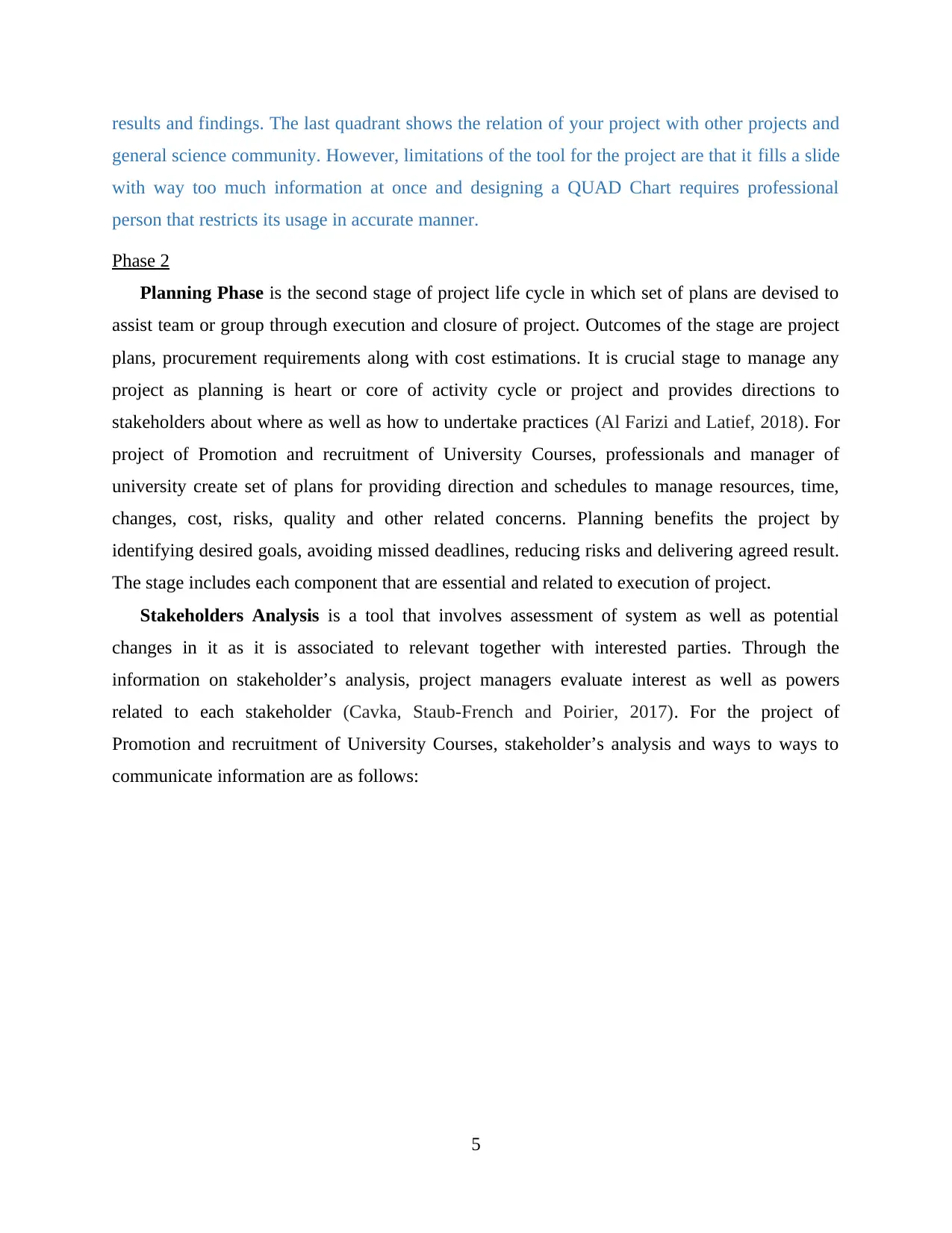
results and findings. The last quadrant shows the relation of your project with other projects and
general science community. However, limitations of the tool for the project are that it fills a slide
with way too much information at once and designing a QUAD Chart requires professional
person that restricts its usage in accurate manner.
Phase 2
Planning Phase is the second stage of project life cycle in which set of plans are devised to
assist team or group through execution and closure of project. Outcomes of the stage are project
plans, procurement requirements along with cost estimations. It is crucial stage to manage any
project as planning is heart or core of activity cycle or project and provides directions to
stakeholders about where as well as how to undertake practices (Al Farizi and Latief, 2018). For
project of Promotion and recruitment of University Courses, professionals and manager of
university create set of plans for providing direction and schedules to manage resources, time,
changes, cost, risks, quality and other related concerns. Planning benefits the project by
identifying desired goals, avoiding missed deadlines, reducing risks and delivering agreed result.
The stage includes each component that are essential and related to execution of project.
Stakeholders Analysis is a tool that involves assessment of system as well as potential
changes in it as it is associated to relevant together with interested parties. Through the
information on stakeholder’s analysis, project managers evaluate interest as well as powers
related to each stakeholder (Cavka, Staub-French and Poirier, 2017). For the project of
Promotion and recruitment of University Courses, stakeholder’s analysis and ways to ways to
communicate information are as follows:
5
general science community. However, limitations of the tool for the project are that it fills a slide
with way too much information at once and designing a QUAD Chart requires professional
person that restricts its usage in accurate manner.
Phase 2
Planning Phase is the second stage of project life cycle in which set of plans are devised to
assist team or group through execution and closure of project. Outcomes of the stage are project
plans, procurement requirements along with cost estimations. It is crucial stage to manage any
project as planning is heart or core of activity cycle or project and provides directions to
stakeholders about where as well as how to undertake practices (Al Farizi and Latief, 2018). For
project of Promotion and recruitment of University Courses, professionals and manager of
university create set of plans for providing direction and schedules to manage resources, time,
changes, cost, risks, quality and other related concerns. Planning benefits the project by
identifying desired goals, avoiding missed deadlines, reducing risks and delivering agreed result.
The stage includes each component that are essential and related to execution of project.
Stakeholders Analysis is a tool that involves assessment of system as well as potential
changes in it as it is associated to relevant together with interested parties. Through the
information on stakeholder’s analysis, project managers evaluate interest as well as powers
related to each stakeholder (Cavka, Staub-French and Poirier, 2017). For the project of
Promotion and recruitment of University Courses, stakeholder’s analysis and ways to ways to
communicate information are as follows:
5
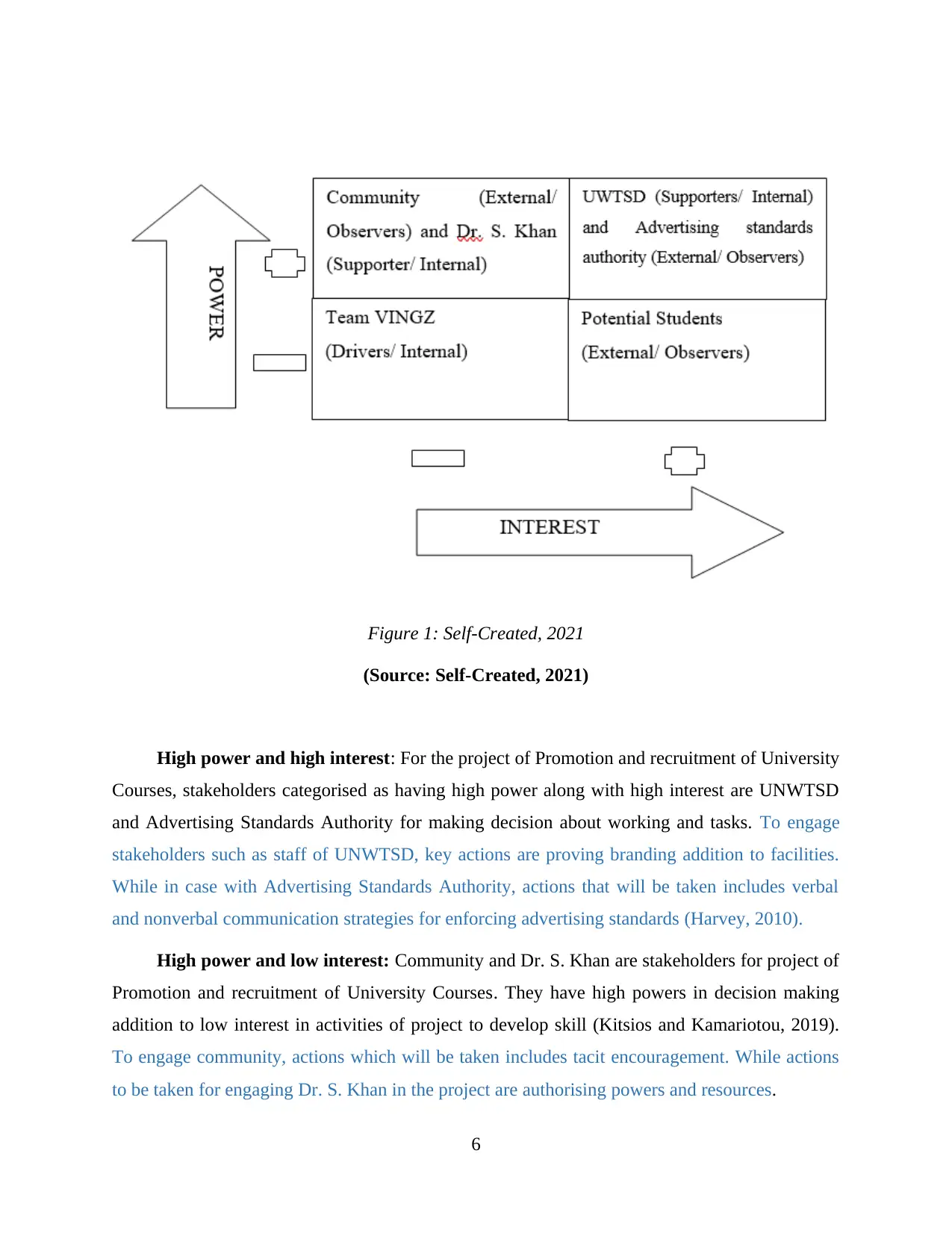
Figure 1: Self-Created, 2021
(Source: Self-Created, 2021)
High power and high interest: For the project of Promotion and recruitment of University
Courses, stakeholders categorised as having high power along with high interest are UNWTSD
and Advertising Standards Authority for making decision about working and tasks. To engage
stakeholders such as staff of UNWTSD, key actions are proving branding addition to facilities.
While in case with Advertising Standards Authority, actions that will be taken includes verbal
and nonverbal communication strategies for enforcing advertising standards (Harvey, 2010).
High power and low interest: Community and Dr. S. Khan are stakeholders for project of
Promotion and recruitment of University Courses. They have high powers in decision making
addition to low interest in activities of project to develop skill (Kitsios and Kamariotou, 2019).
To engage community, actions which will be taken includes tacit encouragement. While actions
to be taken for engaging Dr. S. Khan in the project are authorising powers and resources.
6
(Source: Self-Created, 2021)
High power and high interest: For the project of Promotion and recruitment of University
Courses, stakeholders categorised as having high power along with high interest are UNWTSD
and Advertising Standards Authority for making decision about working and tasks. To engage
stakeholders such as staff of UNWTSD, key actions are proving branding addition to facilities.
While in case with Advertising Standards Authority, actions that will be taken includes verbal
and nonverbal communication strategies for enforcing advertising standards (Harvey, 2010).
High power and low interest: Community and Dr. S. Khan are stakeholders for project of
Promotion and recruitment of University Courses. They have high powers in decision making
addition to low interest in activities of project to develop skill (Kitsios and Kamariotou, 2019).
To engage community, actions which will be taken includes tacit encouragement. While actions
to be taken for engaging Dr. S. Khan in the project are authorising powers and resources.
6
⊘ This is a preview!⊘
Do you want full access?
Subscribe today to unlock all pages.

Trusted by 1+ million students worldwide
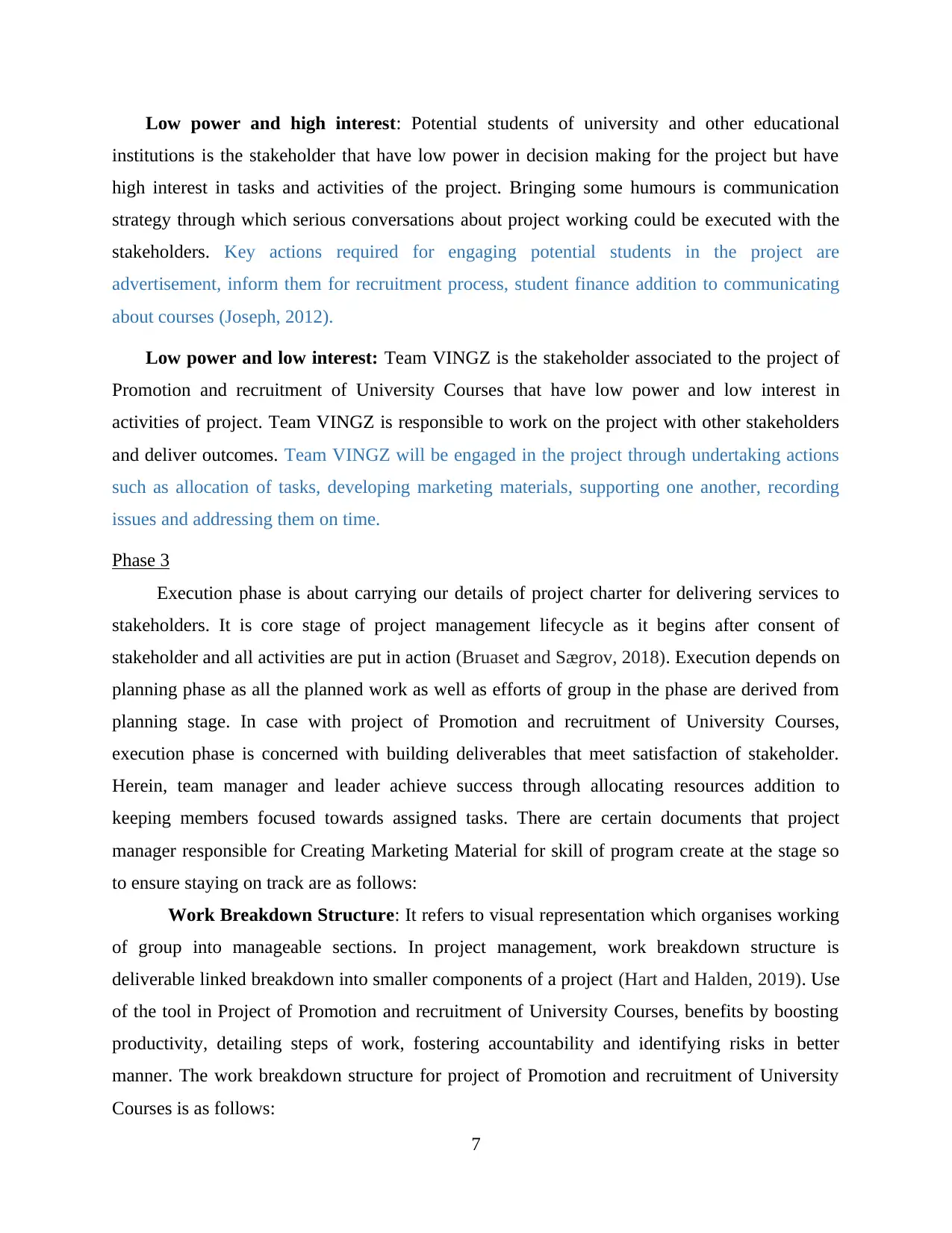
Low power and high interest: Potential students of university and other educational
institutions is the stakeholder that have low power in decision making for the project but have
high interest in tasks and activities of the project. Bringing some humours is communication
strategy through which serious conversations about project working could be executed with the
stakeholders. Key actions required for engaging potential students in the project are
advertisement, inform them for recruitment process, student finance addition to communicating
about courses (Joseph, 2012).
Low power and low interest: Team VINGZ is the stakeholder associated to the project of
Promotion and recruitment of University Courses that have low power and low interest in
activities of project. Team VINGZ is responsible to work on the project with other stakeholders
and deliver outcomes. Team VINGZ will be engaged in the project through undertaking actions
such as allocation of tasks, developing marketing materials, supporting one another, recording
issues and addressing them on time.
Phase 3
Execution phase is about carrying our details of project charter for delivering services to
stakeholders. It is core stage of project management lifecycle as it begins after consent of
stakeholder and all activities are put in action (Bruaset and Sægrov, 2018). Execution depends on
planning phase as all the planned work as well as efforts of group in the phase are derived from
planning stage. In case with project of Promotion and recruitment of University Courses,
execution phase is concerned with building deliverables that meet satisfaction of stakeholder.
Herein, team manager and leader achieve success through allocating resources addition to
keeping members focused towards assigned tasks. There are certain documents that project
manager responsible for Creating Marketing Material for skill of program create at the stage so
to ensure staying on track are as follows:
Work Breakdown Structure: It refers to visual representation which organises working
of group into manageable sections. In project management, work breakdown structure is
deliverable linked breakdown into smaller components of a project (Hart and Halden, 2019). Use
of the tool in Project of Promotion and recruitment of University Courses, benefits by boosting
productivity, detailing steps of work, fostering accountability and identifying risks in better
manner. The work breakdown structure for project of Promotion and recruitment of University
Courses is as follows:
7
institutions is the stakeholder that have low power in decision making for the project but have
high interest in tasks and activities of the project. Bringing some humours is communication
strategy through which serious conversations about project working could be executed with the
stakeholders. Key actions required for engaging potential students in the project are
advertisement, inform them for recruitment process, student finance addition to communicating
about courses (Joseph, 2012).
Low power and low interest: Team VINGZ is the stakeholder associated to the project of
Promotion and recruitment of University Courses that have low power and low interest in
activities of project. Team VINGZ is responsible to work on the project with other stakeholders
and deliver outcomes. Team VINGZ will be engaged in the project through undertaking actions
such as allocation of tasks, developing marketing materials, supporting one another, recording
issues and addressing them on time.
Phase 3
Execution phase is about carrying our details of project charter for delivering services to
stakeholders. It is core stage of project management lifecycle as it begins after consent of
stakeholder and all activities are put in action (Bruaset and Sægrov, 2018). Execution depends on
planning phase as all the planned work as well as efforts of group in the phase are derived from
planning stage. In case with project of Promotion and recruitment of University Courses,
execution phase is concerned with building deliverables that meet satisfaction of stakeholder.
Herein, team manager and leader achieve success through allocating resources addition to
keeping members focused towards assigned tasks. There are certain documents that project
manager responsible for Creating Marketing Material for skill of program create at the stage so
to ensure staying on track are as follows:
Work Breakdown Structure: It refers to visual representation which organises working
of group into manageable sections. In project management, work breakdown structure is
deliverable linked breakdown into smaller components of a project (Hart and Halden, 2019). Use
of the tool in Project of Promotion and recruitment of University Courses, benefits by boosting
productivity, detailing steps of work, fostering accountability and identifying risks in better
manner. The work breakdown structure for project of Promotion and recruitment of University
Courses is as follows:
7
Paraphrase This Document
Need a fresh take? Get an instant paraphrase of this document with our AI Paraphraser
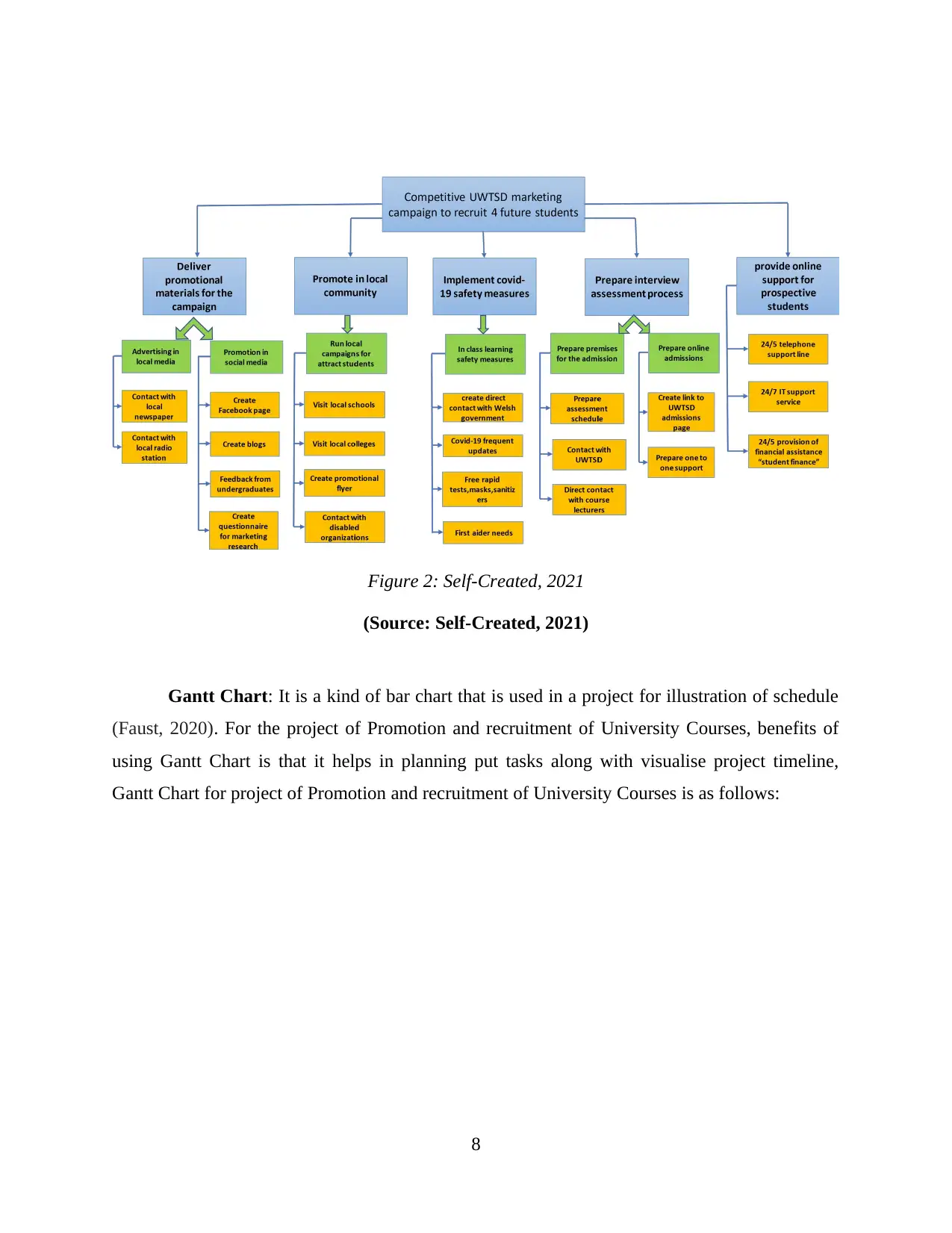
Figure 2: Self-Created, 2021
(Source: Self-Created, 2021)
Gantt Chart: It is a kind of bar chart that is used in a project for illustration of schedule
(Faust, 2020). For the project of Promotion and recruitment of University Courses, benefits of
using Gantt Chart is that it helps in planning put tasks along with visualise project timeline,
Gantt Chart for project of Promotion and recruitment of University Courses is as follows:
8
(Source: Self-Created, 2021)
Gantt Chart: It is a kind of bar chart that is used in a project for illustration of schedule
(Faust, 2020). For the project of Promotion and recruitment of University Courses, benefits of
using Gantt Chart is that it helps in planning put tasks along with visualise project timeline,
Gantt Chart for project of Promotion and recruitment of University Courses is as follows:
8
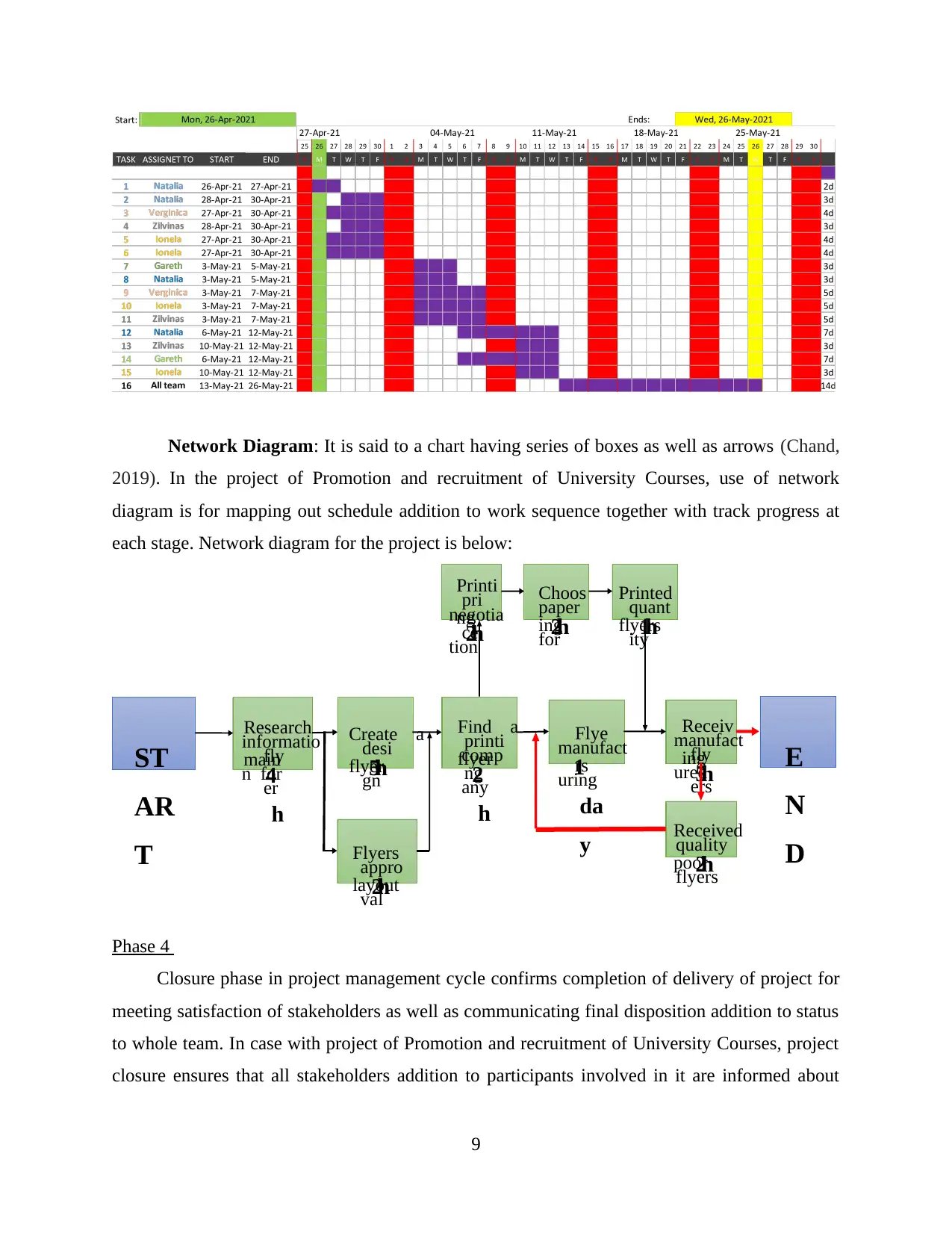
Network Diagram: It is said to a chart having series of boxes as well as arrows (Chand,
2019). In the project of Promotion and recruitment of University Courses, use of network
diagram is for mapping out schedule addition to work sequence together with track progress at
each stage. Network diagram for the project is below:
Phase 4
Closure phase in project management cycle confirms completion of delivery of project for
meeting satisfaction of stakeholders as well as communicating final disposition addition to status
to whole team. In case with project of Promotion and recruitment of University Courses, project
closure ensures that all stakeholders addition to participants involved in it are informed about
9
ST
AR
T
E
N
D
Create a
flyer
desi
gn
h5
Find a
flyer
printi
ng
comp
any
h
2
Flyers
layout
appro
val
h2
Receiv
ing
manufact
ured
fly
ers
h5
Flye
rs
manufact
uring
1
da
y
Choos
ing
paper
for
2h
Research
main
informatio
n for
fly
er
4
h
Printed
flyers
quant
ity
1h
Printi
ng
pri
ce
negotia
tion
h2
Received
poor
quality
flyers
2h
2019). In the project of Promotion and recruitment of University Courses, use of network
diagram is for mapping out schedule addition to work sequence together with track progress at
each stage. Network diagram for the project is below:
Phase 4
Closure phase in project management cycle confirms completion of delivery of project for
meeting satisfaction of stakeholders as well as communicating final disposition addition to status
to whole team. In case with project of Promotion and recruitment of University Courses, project
closure ensures that all stakeholders addition to participants involved in it are informed about
9
ST
AR
T
E
N
D
Create a
flyer
desi
gn
h5
Find a
flyer
printi
ng
comp
any
h
2
Flyers
layout
appro
val
h2
Receiv
ing
manufact
ured
fly
ers
h5
Flye
rs
manufact
uring
1
da
y
Choos
ing
paper
for
2h
Research
main
informatio
n for
fly
er
4
h
Printed
flyers
quant
ity
1h
Printi
ng
pri
ce
negotia
tion
h2
Received
poor
quality
flyers
2h
⊘ This is a preview!⊘
Do you want full access?
Subscribe today to unlock all pages.

Trusted by 1+ million students worldwide
1 out of 17
Related Documents
Your All-in-One AI-Powered Toolkit for Academic Success.
+13062052269
info@desklib.com
Available 24*7 on WhatsApp / Email
![[object Object]](/_next/static/media/star-bottom.7253800d.svg)
Unlock your academic potential
Copyright © 2020–2025 A2Z Services. All Rights Reserved. Developed and managed by ZUCOL.





